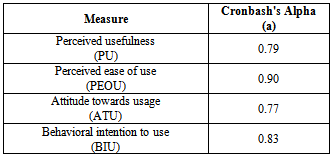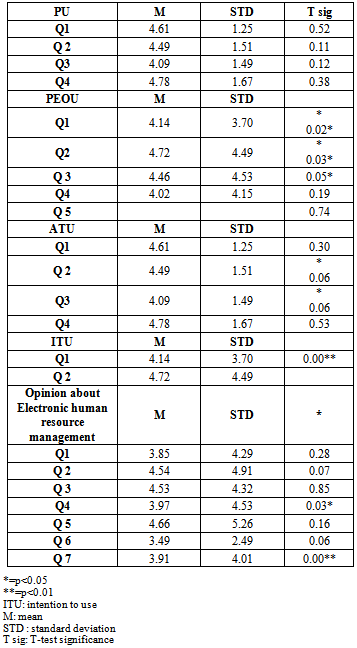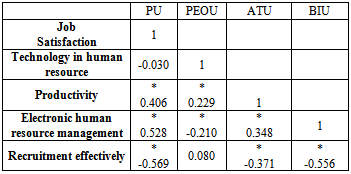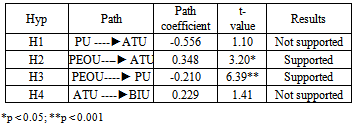-
Paper Information
- Paper Submission
-
Journal Information
- About This Journal
- Editorial Board
- Current Issue
- Archive
- Author Guidelines
- Contact Us
Human Resource Management Research
p-ISSN: 2169-9607 e-ISSN: 2169-9666
2014; 4(2): 33-39
doi:10.5923/j.hrmr.20140402.04
The Effect of Implementing Technology in HRM on the Level of Employee Motivation
Khalil Ghazzawi1, Pierre Al-Khoury2, Judy Saman3
1Assistant Professor, College of Business Administration, Management Department, Rafik Hariri University, Lebanon
2Assistant Professor, College of business Administration, Chair of Management Department, Rafik Hariri University
3MBA Student, Marketing Director at Maxx Stores, Lebanon
Correspondence to: Pierre Al-Khoury, Assistant Professor, College of business Administration, Chair of Management Department, Rafik Hariri University.
| Email: |  |
Copyright © 2014 Scientific & Academic Publishing. All Rights Reserved.
Organizations are facing more challenges than they ever did due to the rapid, dynamic growth of e-business which has lead companies to seek greater opportunities to run HR operations more effectively by implementing technology in the Human Resource department. Nowadays top leaders fully realize the power of information technology (IT) tools for reaching business targets. Therefore the purpose of this paper is to evaluate the present and emerging concepts of the Electronic Human Resource Management in the Lebanese organizations and study how it shapes employees values, perceptions, and behavior. The aim of this paper is to examine the successful factors that influence the effectiveness of human resource (HR) dashboards and the antecedents which motivate employees to use them, and to see the impact and outcomes that technology has on the level of employee's motivation. A survey was carried out; many techniques were used to examine the impact of implementing technology on employee's motivation, such as the descriptive statistics, hypothesis t-test, Pearson correlation and factor analysis. The paper results suggested a strong influence of perceived ease of use of electronic human resource management on the employee's attitudes of using E-HRM. The paper revealed that perceived ease of use is more important than perceived usefulness; it is the main predictor of the attitude towards implementing electronic human resource management. We have examined research done on executive information systems (EIS) and have developed models of the factors which lead to HR electronic use and success. The following paper gives a brief overview about possibilities of IT usage in HR field for measuring and tracking human capital and using the HR information system generally in Lebanese firms focusing on motivational factors.
Keywords: Information Technology, Human Resources Management, E-HRM, Development, Effectiveness, Motivation
Cite this paper: Khalil Ghazzawi, Pierre Al-Khoury, Judy Saman, The Effect of Implementing Technology in HRM on the Level of Employee Motivation, Human Resource Management Research, Vol. 4 No. 2, 2014, pp. 33-39. doi: 10.5923/j.hrmr.20140402.04.
Article Outline
- Part I: The Theoretical Part
1. Introduction
- Human Resources functions are critical in creating effective and efficient organizations. However, success in Human Resources management (HRM) requires change in its focus, role, and delivery systems [61]. (53; Fletcher 2005) stated that the combination of the possibility of current information and communication technology on one hand and the need to work more efficiently on the other are the results of shifting electronic HR systems (E-HRM). E-HRM is defined as the application of any technology enabling managers and employees to have direct access to HR and other services such as performance, communication, team management, reporting, knowledge management, and administrative applications, (Wyatt, 2002). It's a way of implementing HR strategies, policies and practices in organization through a conscious and directed support with the full use of web-technology-based channels [52]. Electronic human resource practices focus on web- technology-based channels to reduce cost, improve strategic orientation and improve HR services that result in better outcomes. This caused organizations to shift from traditional HRM to E-HRM.The purpose of this paper is to examine the effect that electronic human resources have on the level of employee's motivation, and provide practical guidance for actual business application. The technology acceptance model theory (TAM) [11] is applied in this paper to provide a theoretical background and interprets the results (see figure 1).
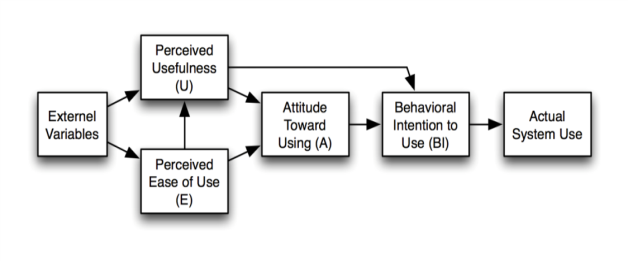 | Figure 1. Technology Acceptance Model .Source (11) |
1.1. Problem Statement
- This paper uses the TAM as a theoretical base to study technology acceptance measures; ease of use (PEOU) and usefulness (PU) [11]. The TAM provides a framework for the decision of employees on how and when they will use the new technology.Generally, companies integrate technology in their human resources management to increase profitability and reduce costs. However, this might not be readily achieved in some industries where HR innovation is not considered as a new force for success but rather a pitfall for employees. Employees need to be motivated to ensure success in technology implementation in HRM [1]. It is therefore interesting to determine the outcomes of e-HRM, the problem to be researched is to examine if E-HRM brings positive or negative outcomes to its users. The issues that will be researched in this paper are the effectiveness of the new systems adopted, the challenges and arising opportunities, and the HR functions in the digital age.
1.2. Research Questions
- The specific research question for this Paper: What is the impact of electronic human resource management on the level of employee's motivation?The main research question is divided into sub- research questions:1. "How does the ease of use of technology affect the level of employee's motivation?"2. "Is the implementation of technology in HRM considered a tool to identify employee's strengths and weaknesses?"3. "How will employees, line managers and supervisors work together to sustain, improve, or build on existing electronic human resources?"4. "What are the external factors affecting organizational performance in general?"5. "What is the relationship between employee's motivation and electronic human resources?
1.3. Significance of the Research
- This research identifies the effectiveness of electronic human resource management in Lebanon's organizations and explains the effect of implementing technology in the human resource department and the influence it has on employee's motivation. Employee's behaviors towards e-HRM are investigated in the light of the TAM model as well as the relationship between subjective norms and the employees’ willingness to accept such technology, in addition to other factors like perception of external control, objective usability, perceived enjoyment and computer anxiety [58]. Results of the paper are supposed to show the impact of e-HRM practice on employee's motivation.
2. Literature Review
- The term "human resource management" has been commonly used for about the last ten to fifteen years. Prior to that, the field was generally known as "personnel administration." Today’s business environment along with the increasing importance of technology requires smart thinking, quick action and rapid adaptation to constantly changing conditions. Technology is changing by the second and becoming increasingly sophisticated, smart and accessible. The Internet, along with the availability of powerful and efficient computer software systems, has revolutionized the whole business activity (Ziynuska & al., 2007). It is expanding organizational boundaries and involving additional stakeholders in the business process, thus forming another challenge to HRM.
2.1. Definition of E-HRM and Its Function
- E-HR stands for Electronic Human Resources and it reflects the automation of HRM work. The literature does not provide a consistent definition of e-HR, as the term is used interchangeably with “HRIS” (Human Resource Information Systems), “HRMS” (Human Resource Management Systems), “HR software”, “Web-based HR”, “HR Self Service”, “B2E” (Business to Employee), and other terms. As per Hopkins and Markham E-HR is “the strategic application of web-based technologies to HR-related systems which, along with other organizational changes, will lead to more broadly-based access to HR information and wider opportunities for managing that information” [23].E-HRM helps in improving efficiency, reduces head count, saves money and get things done, which reduces the use of paper and lowers the administrative burden for people. It has the capacity to allow Human resource management to become more strategic by giving the H.R managers the authority to have more impact on business decision making, and giving more time to make decisions instead of doing transactional actions. It provides the human resource managers with accurate, reliable data about their management which feeds in business decisions [23].
2.2. Problems of E-HRM
- Developing, overseeing, and coordinating appraisal is the primary responsibility of E-HR. Managerial and employee cooperation or participation is not only a positive input into the process other it is encouraged since participation implies commitment to the program and to its objectives. Performance appraisal today also emphasizes objective means of measurement and the integration of appraisal into a widespread, perpetual development process [49]. For the organization in general and HRM in particular, performance appraisal operates as a feedback system on activities such as employee placement, HRM research, HRP, compensation, and career development among others. Even if the appraisal process is carefully designed, its implementation may fail due to lack of management support. Standards that do not relate to the content of the job and appraiser bias may also impede the process. Managers are especially reluctant to carry out appraisal interviews for they may underestimate its potential benefits, they may feel uncomfortable with the meeting, or they may lack the necessary skills. Moreover, managers may resent the conflicting roles of judging and developing [49].
2.3. Theory of Motivation
- Motivation has been defined as "all those inner conditions described as wishes, desires, drives, etc... It is an inner state that activates or moves" [16]. Moreover, motivation has always been referred to "as an intervening variable" [18]. Schein, in Organizational Psychology, defines motivation as impulses that stem from within a person and lead him to act in ways that will satisfy these impulses [14]. The question of how to motivate people has been philosophically and practically posed in many eras and many tongues. Basic motivational theories, such as Maslow’s hierarchy of needs theory, Herzberg’s two-factor theory and McClelland’s acquired needs theory, are introduced to understand motivation. This paper introduces the expectancy theory as an integrative motivational approach in E-HRM implementation.The expectancy theory is selected among other motivational theories to provide the guidelines for our analysis in this paper. The reasons for choosing this theory in particular is that many elements of other motivational theories can be accommodated within the larger framework of expectancy theory, thus providing it with a special strength of becoming an integrating motivational approach.
2.4. Impact of E-HRM on Employee Motivation
- Impacts of E-HRM on employee motivation can be better understood in the following figure.The Power of I’s
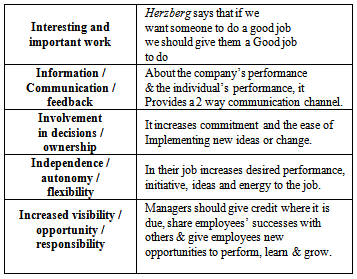 | Figure 2. Source: (1) |
2.5. Concluding Remarks: Towards E-HRM Strategic Partnership
- Finally, the return on investment has fallen short of expectations as per study conducted by Towers Perrin (a consulting firm). Similarly, in a survey that measured E-HR effects on financial results, Watson Wyatt found that organizations that implemented E-HR with a primary disciplined and narrow focus (quantifiable goals like reducing cost), increased their market financial value, while organizations that used technology for the softer goals, like promoting corporate culture, decreased their shareholder value [34]. Technology might also form a threat to the survival and importance of the personnel specialists in the organization. Despite these, technology has become a determinant for attracting candidates. Technology is also providing individuals with easier access to organizational information, giving employees access to package information in their organization and others available in the market, thus enabling them with ample opportunity for comparison, and increasing chances of employees’ turnover.Part II: The Practical Part
3. Research Methodology
- The methodology of this research embraces both literature survey and empirical investigation. The purpose of the paper is to investigate how employees respond to various organizational factors, and how they accept such practices in their daily work. This research will be based on operationalizing that assists in determining quantitative measures for the variables in the research. “Operationalizing a variable means finding a measurable, quantifiable, and valid index for your variable (independent and dependent variables), and (sometimes) finding a way to manipulate that variable in such a way as to have two or more levels.” Descriptive research (Hair & al., 2007) is adopted in this paper to enable obtaining of data which describes characteristics of the topic of research interest. It is used for describing various factors under study such as objects, people, or even organizations and address questions to each.The target population, in this case is the employees that work in organizations. Sample consists of 162 staff members selected randomly. Primary and secondary data are considered. The primary data was collected through the questionnaire comprising of 22 questions starting with the multiple choice questions regarding the age, gender, educational level; in addition to, Likert-type scale questions, while secondary data consist of results from literature survey.Several limitations were faced in the conduct of the paper. Data are collected from companies' employees in Lebanon. The respondents’ awareness about the topic under study posts restrictions which affects the accuracy of the answers on the questions asked. Secondly, technology faces rapid and dynamic growth which makes study findings in a certain period of time irrelevant in the future time.
4. Analysis and Findings
- The Cronbach’s alpha test was applied to expose the internal consistency of the scale and the sample that had been taken. The Cronbach alpha ranges from 0 to 1. The more the result is close to 1; it will show higher level of internal consistency. And in case, it moves toward the 0 level, the lower level of internal consistency will be seen.The reliabilities (Cronbach’s alpha) for the different measures were calculated as follows:
|
|
|
|
|
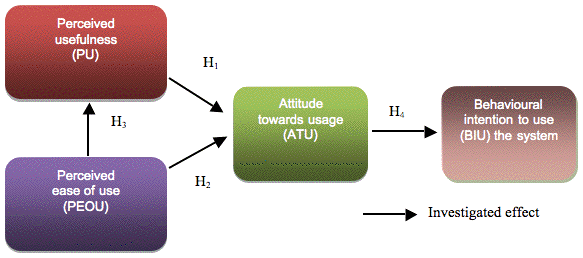 | Figure 3. Hypothesis results, Source; Davis et. al. (11), Venkatesh et. al. (2003) |
5. Discussion and Conclusions
5.1. Conclusions
- The objective of the paper was to examine the impact of electronic Human Resource in Lebanese Companies and the effect it has on employee’s motivation. It also aimed to paper the relationships of the three constructs with demographic variables and the relationships among them.The paper gave support to some of the hypotheses that lead us to conclude that there is a relationship between perceived ease of use and the attitude towards using. The paper did not show any negative relation between the two factors, this means that employees accept the new technology according to their attitude so when employees find the electronic human resource department a good idea this would encourage them to accept it, they would interact to technology easier, it would be clearer to them of their interaction. This would lead to a better attitude to the employees, they would come to work with a good feeling, they will be excited to work and give good outcomes, and thus they are more motivated to work and satisfied.Moreover, there was partial support pertaining to the statement that perceived usefulness is negatively related to attitude towards using. This implies that organizations aiming to increase employee motivation must mostly focus on fostering Electronic human resource management by first seeing employees’ attitude towards using such innovation.The reason of which, we conclude, is that the HRD had a solid plan in place to introduce an E-HRM, realized as follows: 1) The software selection process was well studied; companies should choose the E-HRM based on a) meeting its needs, b) considering E-HRM as the “best answer” after having checked other solutions, c) the organization should implement a training program for employeesWith E-HR we have witnessed a change in the role of the HR professional when1) Some of its previous administrative responsibilities were shifted to line managers and the employees,2) Software replaced the HR administrator’s manual work of consolidating data and preparing reports.3) Software ensured compliance and standardization of processes. In short, the software application was performing better than the HR administrator with faster, real-time and error-free processing of data.E-HR has also brought new opportunities to HR professionals by lifting the burden of administrative and operational tasks off their shoulders and opening the horizons for a new transformational role. The new role of the HR professional builds on administrative excellence, supported by the software application, to act in fulfillment of the organization’s strategy. E-HR came with the promise of transforming HRM into a strategic business partner by freeing up HR professionals time and streamlining processes and workflows. Its use became widespread in organizations and many scholars have even associated its strategic impact in its definition. Others went further to warn HR from “disappearing” if it does not embrace technology.
5.1.1. Recommendations for Future Research
- A company willing to implement technology in its human resource department should take the following actions for the future to be effective and efficient:First and foremost, the HR department should provide a training program for the employees that would teach them how to use the new system applied. Training programs should be done in small teams not all at once so it's easy for the employee to understand the new system, why it's being implemented, its advantages and usage. The HR department has to implement procedures in a way that employees can plan their career. The HR department has to describe how employees are assessed so that they can improve their weakness points. E-HR options should be flexible so employees feel comfortable while practicing such system. Good HR technology experts that should be there all the way to teach the employees the new system being implemented in order to accept it. The HR department should continue on following the employees work to provide fair feedback on each one, and those having difficulties in giving good outcomes should have special focus. Better organizational structure should be taken care to ensure successful E-HRM that has E-HRM implementation.
 Abstract
Abstract Reference
Reference Full-Text PDF
Full-Text PDF Full-text HTML
Full-text HTML